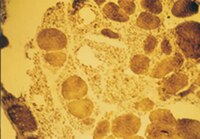Extensive loss of arterial medial smooth muscle cells and mural extracellular matrix in cerebral autosomal recessive arteriopathy with subcortical infarcts and leukoencephalopathy (CARASIL).
Takashi Oide,Hiroshi Nakayama,Sohei Yanagawa,Nobuo Ito,Shu-Ichi Ikeda,Kunimasa Arima
Neuropathology : official journal of the Japanese Society of Neuropathology
28
2008
Show Abstract
Cerebral autosomal recessive arteriopathy with subcortical infarcts and leukoencephalopathy (CARASIL) is a distinctive clinicopathologic entity characterized by young adult-onset non-hypertensive vasculopathic encephalopathy accompanied by alopecia and disco-vertebral degeneration. CARASIL arteriopathy is histopathologically characterized by intense arteriosclerosis without the deposition of granular osmiophilic materials. Until now, the obliterative arteriosclerosis is the presumptive cause of subcortical ischemia in CARASIL; however, a detailed vascular pathology leading to diffuse leukoencephalopathy remains unclear. In this study, we examined two autopsied CARASIL brains in comparison with an autopsy case of cerebral autosomal dominant arteriopathy with subcortical infarcts and leukoencephalopathy (CADASIL). Intensity of arterial sclerotic changes of CARASIL was evaluated by sclerotic index analysis. Immunohistochemical investigations were performed using a battery of primary antibodies, which recognized vascular cellular and extracellular components. As a result, sclerotic changes were disclosed to be mild and infrequent in CARASIL, in contrast to CADASIL that showed severe obliterative arterial changes. In CARASIL, conversely, most of the arteries were centrifugally enlarged and some were collapsed. We further revealed that arterial medial smooth muscle cells (SMCs) in patients with CARASIL were extensively lost, even in arteries without sclerotic changes. Arterial adventitia in CARASIL was conspicuously thin and immunoreactivities for type I, III, and VI collagens and fibronectin were appreciably weak in this region, indicating a reduction in the mural extracellular matrix (ECM). Because of the medial and adventitial degeneration, CARASIL brains likely receive marked fluctuations in blood flow because of deviations in the structural and functional basis of autoregulation mechanisms. We thus consider that diffuse leukoencephalopathy in CARASIL may be caused by arterial medial SMC loss with mural ECM reduction. We speculate that the abnormalities in the ECM are causatively related to the SMC degeneration, since the ECM is a crucial signal determining the biophysiological properties of arterial SMCs. | 18021191
 |
Role of ubiquitin-like protein FAT10 in epithelial apoptosis in renal disease.
Ross, MJ; Wosnitzer, MS; Ross, MD; Granelli, B; Gusella, GL; Husain, M; Kaufman, L; Vasievich, M; D'Agati, VD; Wilson, PD; Klotman, ME; Klotman, PE
Journal of the American Society of Nephrology : JASN
17
996-1004
2006
Show Abstract
Dysregulated apoptosis of renal tubular epithelial cells (RTEC) is an important component of the pathogenesis of several renal diseases, including HIV-associated nephropathy (HIVAN), the most common cause of chronic kidney failure in HIV-infected patients. In HIVAN, RTEC become infected by HIV-1 in a focal distribution, and HIV-1 infection has been shown to induce apoptosis in vitro. In microarray studies that used a novel renal tubular epithelial cell line from a patient with HIVAN, it was found that the ubiquitin-like protein FAT10 is one of the most upregulated genes in HIV-infected cells. Previously, FAT10 was shown to induce apoptosis in murine fibroblasts. The expression of FAT10 in HIVAN and the ability of FAT10 to induce apoptosis in human RTEC therefore were studied. This study revealed that FAT10 expression is induced after infection of RTEC by HIV-1 and that expression of FAT10 induces apoptosis in RTEC in vitro. Moreover, it was found that inhibition of endogenous FAT10 expression abrogated HIV-induced apoptosis of RTEC. Immunohistochemical studies demonstrated increased FAT10 expression in a murine model of HIVAN, in HIVAN biopsy samples, and in autosomal dominant polycystic kidney disease, another renal disease that is characterized by cystic tubular enlargement and epithelial apoptosis. These results suggest a novel role for FAT10 in epithelial apoptosis, which is an important component of the pathogenesis of many renal diseases. | 16495380
 |










